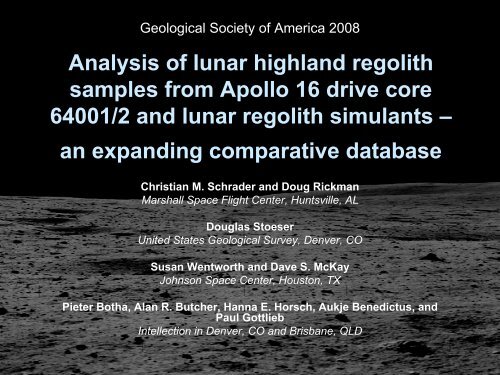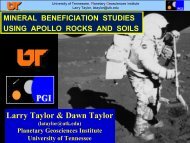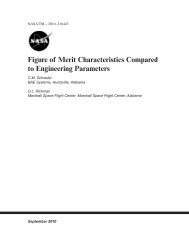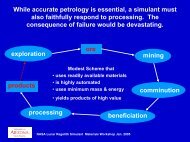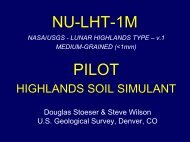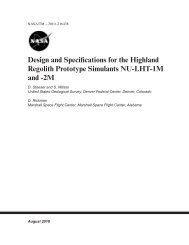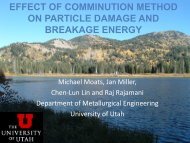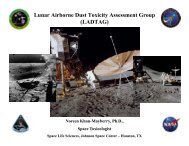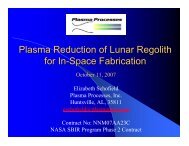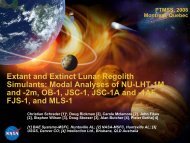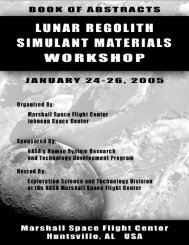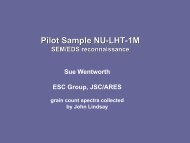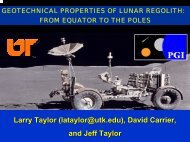Analysis of lunar highland regolith samples from Apollo 16 drive ...
Analysis of lunar highland regolith samples from Apollo 16 drive ...
Analysis of lunar highland regolith samples from Apollo 16 drive ...
- No tags were found...
Create successful ePaper yourself
Turn your PDF publications into a flip-book with our unique Google optimized e-Paper software.
Geological Society <strong>of</strong> America 2008<strong>Analysis</strong> <strong>of</strong> <strong>lunar</strong> <strong>highland</strong> <strong>regolith</strong><strong>samples</strong> <strong>from</strong> <strong>Apollo</strong> <strong>16</strong> <strong>drive</strong> core64001/2 and <strong>lunar</strong> <strong>regolith</strong> simulants –an expanding comparative databaseChristian M. Schrader and Doug RickmanMarshall Space Flight Center, Huntsville, ALDouglas StoeserUnited States Geological Survey, Denver, COSusan Wentworth and Dave S. McKayJohnson Space Center, Houston, TXPieter Botha, Alan R. Butcher, Hanna E. Horsch, Aukje Benedictus, andPaul GottliebIntellection in Denver, CO and Brisbane, QLD
Outline• Background <strong>of</strong> the <strong>lunar</strong> <strong>regolith</strong>simulant effort• <strong>Apollo</strong> site and sample selection• Results <strong>of</strong> QEMSCAN ® modalanalysis <strong>of</strong> <strong>lunar</strong> material– change in major mineralmodal% with size fraction– comparison <strong>of</strong> major/traceminerals in sieved vs. thinsection <strong>samples</strong>9/15/2008 BAE Systems, Marshall SpaceFlight Center2
Outline, cont.• Results <strong>of</strong> analysis <strong>of</strong> simulantsvs. <strong>Apollo</strong> <strong>samples</strong>• Future, ongoing, and parallel work9/15/2008 BAE Systems, Marshall SpaceFlight Center3
In support <strong>of</strong> a future <strong>lunar</strong> outpost...• This work is part <strong>of</strong> a larger effort to compile an internally consistentdatabase on <strong>lunar</strong> <strong>regolith</strong> (<strong>Apollo</strong> <strong>samples</strong>) and <strong>lunar</strong> <strong>regolith</strong>simulants.– Characterize existing <strong>lunar</strong> <strong>regolith</strong> and simulants in terms <strong>of</strong>• Particle type• Particle size distribution• Particle shape distribution• Bulk density• Other compositional characteristics– Evaluate <strong>regolith</strong> simulants (Figure <strong>of</strong> Merit) by above properties bycomparison to <strong>lunar</strong> <strong>regolith</strong> (<strong>Apollo</strong> sample)9/15/2008 BAE Systems, Marshall SpaceFlight Center4
<strong>Apollo</strong> <strong>16</strong> siteLMStation 4:64001/640029/15/2008 BAE Systems, Marshall SpaceFlight Center5
Station 4 <strong>samples</strong>geochemical data <strong>from</strong> Korotev (1982) and Korotev et al. (1984)64002(Houck, 1982)One thin-section64002,6019: 5.0 – 8.0 cm3.0 4.0 5.0 6.0 7.00100040 50 60 70 80 90 100 110Eight sieved <strong>samples</strong>64002,262: 5.0 – 5.5 cm64001(Basu & McKay, 1984)One thin-section64001,6031: 50.0 – 53.1 cmdepth, centimeters20304050%FeO0000Is/FeOEight sieved <strong>samples</strong>64001,374: 52.0 – 52.5 cm60070<strong>Apollo</strong> <strong>16</strong> core 64001/640020<strong>Apollo</strong> <strong>16</strong> core 64001/640029/15/2008 BAE Systems, Marshall SpaceFlight Center6
Modal analysis <strong>of</strong> sieved grain mounts64002,262 sieved fractions64001,374 sieved fractions7070modal%6050403053504929250-500 μm90-150 μm45-75 μm
Change in modal% by size fraction: 64002,2622.564002, 262fraction/integrated2.01.51.00.5250-500 μm90-150 μm45-75 μm
Change in modal% by size fraction: 64001,3742.564001, 374fraction/integrated2.01.51.00.5250-500 μm90-150 μm45-75 μm
Modal analysis: thin sections versus integratedbulk grain mountsmodal%60504030204440433664002, 6019 (TS)64002, 262 (GM)64001, 6031 (TS)64001, 374 (GM)46444641• Minerals report as higherin thin section than incorresponding integratedgrain mounts.– Edge effects/mixedphases in thin sectionsreport as minerals?– Real effect <strong>from</strong> missingfractions in grain mounts?1003 3 3 31 1 1 1Plagioclase Pyroxene Olivine Glass– Sampling error <strong>from</strong>sieving?• Glass shows less regularpattern.9/15/2008 BAE Systems, Marshall SpaceFlight Center10
Modal analysis: thin sections versus integratedbulk grain mounts0.40• Trace Minerals:modal%0.350.300.250.200.1564002, 6019 (TS)64002, 262 (GM)64001, 6031 (TS)64001, 374 (GM)– Given, the very lowamounts <strong>of</strong> some traceminerals (
Unclassified material in QEMSCAN ® modal analysis40064002,26264001,374350 300 250 200 150 100Middle <strong>of</strong> size bin (μm)500302520151050unclassified (modal%)The modal% <strong>of</strong> unclassifiedmaterial:– ranges <strong>from</strong> ~5-24% in anyone analysis;– tends to increase as sizefraction decreases in grainmounts;Thin sections64002,6019: 6.6% unclassified64001,6031: 6.4% unclassifiedIntegrated grain mounts64002,262: 8.4% unclassified64001,374: <strong>16</strong>.9% unclassified9/15/2008 BAE Systems, Marshall SpaceFlight Center– is higher in integrated grainmounts than in thin sections• (is more materialmisclassified due to edgeeffects and phase mixing?)• (is this <strong>from</strong> another,unknown effect?)12
Lunar simulants: Mare and HighlandsNU-LHT-1M <strong>lunar</strong><strong>highland</strong>s simulantJSC-1A <strong>lunar</strong> maresimulant9/15/2008 BAE Systems, Marshall SpaceFlight Center13
Overview: Major mineral modal comparisonbetween simulants and 64001/64002modal%70605040302010067544445364001/2 TS Avg.NU-LHT-2MNU-LHT-1M45 44OB-1251310 10 1035 5170605040302010053524439 383564001/2 TS Avg.JSC-1JSC-1AJSC-1AFFJS-1MLS-1 3522<strong>16</strong>171412128315145342919178Plagioclase Pyroxene Olivine GlassPlagioclase Pyroxene Olivine GlassHighland simulantsMare simulantsWe are incorporating particle type data (e.g., the presence <strong>of</strong>agglutinates) and phase chemistry into these comparisons.9/15/2008 BAE Systems, Marshall SpaceFlight Center14
Overview: Trace mineral modal comparisonbetween simulants and 64001/64002modal%0.450.400.350.300.250.2064001/2 TS Avg.NU-LHT-2MNU-LHT-1MOB-10.450.400.350.300.250.2064001/2 TS Avg.JSC-1JSC-1AJSC-1AFFJS-1MLS-10.150.150.100.100.050.050.000.00Ilmenite Ap/Whit. Native Fe Spinel SulfidesIlmenite Ap/Whit. Native Fe Spinel SulfidesHighland simulantsMare simulantsWe are incorporating particle type data (e.g., the presence <strong>of</strong>agglutinates) and phase chemistry into these comparisons.9/15/2008 BAE Systems, Marshall SpaceFlight Center15
Further and ongoing work• Continue to analyze <strong>Apollo</strong> <strong>samples</strong> by total phasemodal%.• Incorporate particle type modal analysis by determiningwhich phases are present in lithics, breccias,agglutinates, etc.• Incorporate phase chemistry.• Analyze simulants by these same techniques forcomparison by Figure <strong>of</strong> Merit algorithms.9/15/2008 BAE Systems, Marshall SpaceFlight Center<strong>16</strong>
Parallel workCharacterizing particle size and shapedistributions and bulk densities <strong>of</strong> <strong>lunar</strong><strong>regolith</strong> and simulants for comparison byFoM.9/15/2008 BAE Systems, Marshall SpaceFlight Center17
ReferencesBasu, A. and Mckay, D.S., “Petrologic Pr<strong>of</strong>ile <strong>of</strong> <strong>Apollo</strong> <strong>16</strong> Regolith at Station 4”,Proceedings <strong>of</strong> the 15th Lunar and Planetary Science Conference, Part 1, Journal <strong>of</strong>Geophysical Research, Vol. 89, Supplement, 1984, pp. C133-C142.Houck, K.J., “Modal Petrology <strong>of</strong> Six Soils <strong>from</strong> <strong>Apollo</strong> <strong>16</strong> Double Drive Tube 64002”,Proceedings <strong>of</strong> the 13th Lunar and Planetary Science Conference, Part 1, Journal <strong>of</strong>Geophysical Research, Vol. 87, Supplement, 1982b, pp. A210-A220.Korotev, R.L., “Comparative Geochemistry <strong>of</strong> <strong>Apollo</strong> <strong>16</strong> Surface Soils and Samples<strong>from</strong> Cores 64002 and 60002 through 60007”, Proceedings <strong>of</strong> the 13th Lunar andPlanetary Science Conference, Part 1, Journal <strong>of</strong> Geophysical Research, Vol.. 87,Supplement, 1982, pp. A269-A278.Korotev, R.L., Morris, R.V., and Lauer, H.V., Jr., “Stratigraphy and Geochemistry <strong>of</strong> theStone Mountain Core (64001/2)”, Proceedings <strong>of</strong> the 15th Lunar and PlanetaryScience Conference, Part 1, Journal <strong>of</strong> Geophysical Research, Vol. 89, Supplement,1984, pp. C143-C<strong>16</strong>0.9/15/2008 BAE Systems, Marshall SpaceFlight Center18


